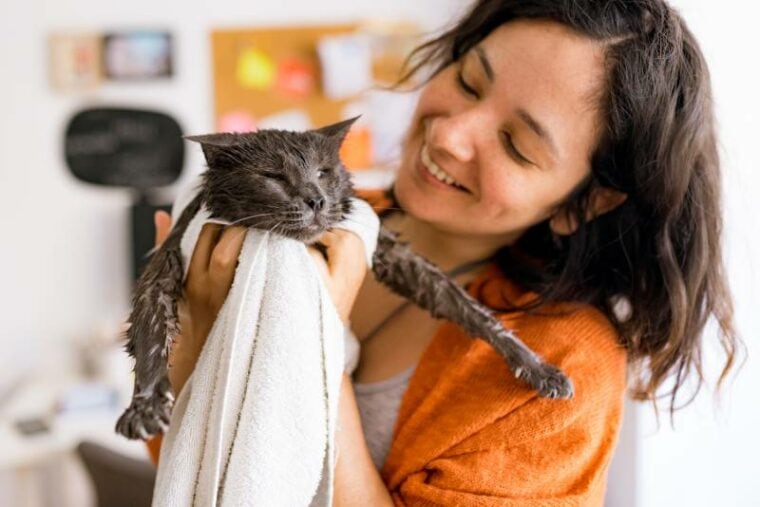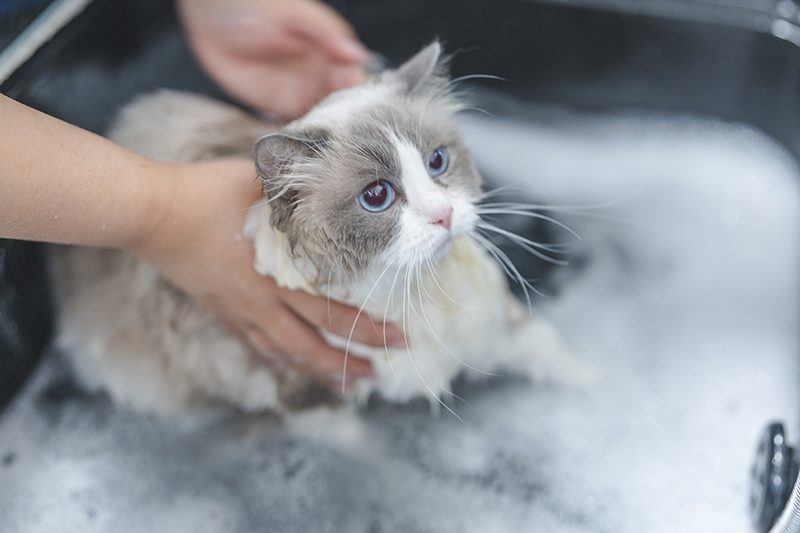
Our cats have a habit of getting into the wackiest hijinks you probably never thought possible, and one of them is getting into adhesives like fly traps around the house. If your cat accidentally runs into one of these sticky insect catchers, they’re probably in some pain as the trap stays stuck on.
To help you remove the trap and get the lingering glue off, we’ve come up with a comprehensive guide—check out what you’ll need and the step-by-step instructions down below so you can get that glue trap off ASAP without harming your cat. That aside, this guide could also work if your cat got into other glues around the house, like mousetraps, craft glue, or wood glue.
Before You Begin
Thankfully, you won’t need any strong chemical cleaners or special equipment to safely clean your cat’s fur. The way you approach the task depends on how severe it is, but in general, you need a handful of things you probably already have lying around the house anyway.
How to Get Fly Trap Glue Off a Cat
1. Physically Remove the Trap and the Adhesive
Fly strips are perniciously sticky, and a cat who’s run into one will absolutely let you know about it. Maybe they’ve got a whole strip stuck to their fur or maybe they’re frantically trying to groom a certain area, but the same rough approach applies. If possible, very slowly and gently pry the fly trap off your cat’s fur while holding the skin taught to minimize potentially alarming fur tugging.
We absolutely don’t recommend using scissors or other physical instruments for this step purely because of the risk to your cat. They could suddenly twist their bodies and get cut, or the fly trap could get even more stuck—you get the picture. If the trap is already twisted up in your cat’s fur, we strongly urge you to consult a vet rather than take matters into your own hands.

2. Apply Oil and a Damp Rag
Once you’ve physically removed the strip and as much glue as possible, which won’t be much, it’s time to dissolve that gunk. Thankfully, the chemical composition of the type of super tacky glue they use in fly strips is made with mishaps like this in mind.
Take any old cooking oil you might have in the kitchen, or a jar of peanut butter if you happen to be out of oil. Carefully dab the affected area of your cat’s fur with a small amount of oil—just a tablespoon or even a teaspoon should work like a charm. As you rub the oil in, you’ll notice the glue start to give way and dissolve, but keep going! It might take several passes to get all the glue off, so be patient.
3. Bathe and Dry Your Cat
Even if it appears you’ve gotten the bulk of the glue out of their fur, it’s best to give them a bath afterward just in case. Yes, we know cats loathe conventional baths, but in this case, it’s necessary to keep them from accidentally licking any stray glue left lingering in their fur. Depending on the ingredients involved and how much they ingest, your cat could become very ill.
Bring your cat to your bathing area without making a big deal about it. Stroke them and talk in a calming, reassuring voice so they don’t get too freaked out. Skittish kitties might panic a little anyway but do your best here for their sake. Use a small dollop of gentle pet shampoo to massage it into their fur and then run a comb through their fur after that while keeping them calm. Even the nicest cats might show you their claws here, which makes keeping up morale critical.
Gently massage the affected area with your fingers or the comb until you’ve extricated all the excess glue, then rinse the area with as little water as you can. Once you’re done, give your saint of a kitty a nice treat and wrap them in a towel to dry off for a few minutes. Alternatively, you can use a hairdryer on a low heat setting held 18 inches away to slowly dry their newly clean fur.

4. Repeat if Needed
If your cat’s fur isn’t sleek and clean at this point, it’s not you; that glue is just really sticky and it’s unlikely you got it all on the first try without being very, very thorough. If your cat is up for it, we suggest repeating the above steps to be 100% certain your cat’s fur is free of any icky fly trap glue. Give your cat a good combing after you’re all done to confirm, and voila, you’re finished!
Conclusion
Cats are lovable but mischievous little scamps that find themselves in the strangest, sometimes funniest situations, like getting a fly trap stuck to their fur. The good news is that the glue dissolves in contact with oily substances, which makes cooking oil the perfect antidote for your cat’s mishap. With a little patience, soap, and water, all but the most severe cases can be solved right at home.
Featured Image Credit: davide bonaldo, Shutterstock






